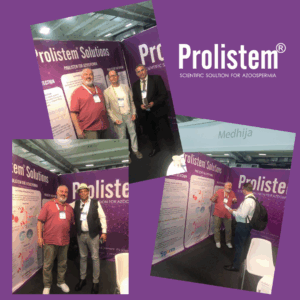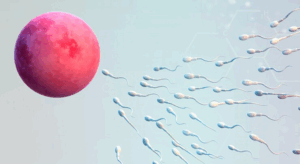
Prolistem® at the ESHRE 41th – Paris
We are proud to have participated in the 41st Annual ESHRE Conference in Paris, a premier international event where the global reproductive medicine community gathers

Azoospermia is one of the most serious male fertility challenges, defined as the complete absence of sperm in the ejaculate. It affects around 1% of all men and up to 15% of infertile men. While surgery has been the traditional approach for many cases, there is growing interest and success in non surgical treatments for azoospermia.
This detailed guide will explore what azoospermia is, the types of non-surgical options available, how effective they are, and everything you need to know if you’re considering a non-surgical path to fatherhood.
Let’s dive in!
Before looking at treatment options, it’s essential to understand the two main types of azoospermia:
Obstructive Azoospermia (OA): Sperm production is normal, but there’s a blockage preventing sperm from reaching the ejaculate.
Non-Obstructive Azoospermia (NOA): The testicles produce little or no sperm due to hormonal issues, genetic conditions, or testicular damage.
The type of azoospermia largely determines whether non-surgical treatments will be effective.
Surgical treatments like TESA, TESE, and Micro-TESE can be invasive, expensive, and come with risks like infection, scarring, and hormonal imbalances.
Non surgical treatments for azoospermia offer several advantages:
Lower risk of complications
Less pain and quicker recovery
More natural hormonal balance
Possibility of natural conception
Cost-effective compared to surgeries
While surgery is necessary in some cases, especially for severe blockages, many men can achieve good results with non-invasive options.
One of the most widely used non surgical treatments for azoospermia is hormonal therapy. This approach is particularly helpful for men with hormonal imbalances or non-obstructive azoospermia.
Clomiphene Citrate (Clomid): Stimulates the brain to release more hormones (FSH and LH) that boost sperm production.
hCG Injections: Mimic the effects of LH, promoting testosterone and sperm development.
FSH Injections: Directly stimulate the testicles to produce sperm.
Aromatase Inhibitors: Such as Anastrozole, help maintain a healthy testosterone-to-estrogen ratio.
Studies show that hormonal therapy can restore sperm in the ejaculate in 30–60% of cases, depending on the cause and duration of treatment.
Important Note:
Patients must be monitored regularly to adjust doses and avoid side effects like mood swings, gynecomastia (breast enlargement), and excessive testosterone levels.
Sometimes, azoospermia is caused by an undetected infection blocking the reproductive tract. In such cases, antibiotics can successfully treat the infection, clear the blockage, and restore sperm flow.
Epididymitis
Prostatitis
Urethritis
Timely antibiotic therapy can prevent long-term damage and is a simple, effective non surgical treatment for azoospermia when infections are the root cause.
It might sound simple, but improving overall health is one of the most underrated non surgical treatments for azoospermia.
Quit smoking: Smoking damages sperm DNA.
Reduce alcohol and drug use: Both can impair sperm production.
Eat a fertility-boosting diet: Rich in antioxidants like Vitamin C, E, and Zinc.
Exercise moderately: Excessive exercise can lower testosterone.
Manage stress: Chronic stress disrupts hormone production.
Avoid heat exposure: Hot tubs, saunas, and tight underwear can harm sperm.
In many mild or borderline cases, lifestyle changes alone can result in the return of sperm to the ejaculate without any medical interventions.
A varicocele is an enlargement of veins within the scrotum that can cause infertility by raising testicular temperature and damaging sperm production.
While surgery (varicocelectomy) is common, there are non surgical treatments for azoospermia related to varicocele management:
Scrotal support: Wearing supportive underwear reduces strain.
Anti-inflammatory medications: To reduce vein swelling.
Lifestyle adjustments: Reducing heavy lifting and prolonged standing.
In mild cases, these non-invasive measures can significantly improve sperm quality without the need for surgery.
Oxidative stress is a major cause of sperm damage. Antioxidants neutralize harmful free radicals, improving sperm health.
Vitamin E and C
Coenzyme Q10
Zinc
Selenium
L-Carnitine
Clinical studies suggest that antioxidant supplementation can increase sperm count and motility, making it an important part of non surgical treatments for azoospermia.
Even if sperm count remains low, many couples successfully conceive using Assisted Reproductive Techniques (ART).
Intrauterine Insemination (IUI): Sperm is collected and directly inserted into the uterus.
Intracytoplasmic Sperm Injection (ICSI): A single sperm is injected into an egg during IVF, even with very low sperm numbers.
In cases where sperm are present but in low quantities, ART eliminates the need for invasive surgical sperm retrieval.
In cases of hypogonadotropic hypogonadism (a rare condition where the brain doesn’t signal the testicles to produce sperm), targeted hormone replacement can restore fertility.
Treatment usually involves:
hCG and FSH injections over several months.
Monitoring testosterone levels and adjusting doses as needed.
HRT has been shown to restore sperm production in up to 80% of affected men, making it one of the most successful non surgical treatments for azoospermia.
Fertility challenges cause immense emotional stress, which can, in turn, impact hormonal balance and sperm production.
Counseling and mindfulness techniques like meditation and yoga have been linked to better outcomes in fertility treatments.
Emotional wellness is often a missing link in the discussion of non surgical treatments for azoospermia, but it plays a vital role.
While non-surgical approaches are effective in many cases, they may not work if:
There’s a complete obstruction that cannot be cleared medically.
The testicles have no sperm-producing cells (Sertoli Cell-Only Syndrome).
There are irreversible genetic defects affecting sperm production.
In such situations, surgical intervention or donor sperm options might still be necessary.
Many men have overcome azoospermia with non-surgical methods:
Case 1: A man with a mild hormonal imbalance achieved natural conception after six months of Clomid therapy and lifestyle changes.
Case 2: A patient with infection-induced azoospermia regained sperm flow after a two-week course of antibiotics.
Case 3: A man with varicocele improved sperm parameters significantly through scrotal support and antioxidant therapy.
These stories show that non-invasive paths can lead to fulfilling family journeys without surgery.
Research continues into exciting new non-surgical therapies, including:
Stem Cell Therapy: Potential to regenerate sperm-producing tissue.
Gene Editing: Correcting genetic defects at the source.
Advanced Hormone Modulators: New medications to fine-tune fertility hormones safely.
The future holds even more promise for men seeking non-surgical solutions to azoospermia.
Azoospermia can feel overwhelming, but non-surgical options offer real hope. Whether through hormonal therapy, lifestyle changes, antioxidant supplementation, or ART, many men have successfully restored fertility without undergoing invasive procedures.
Choosing non surgical treatments for azoospermia means choosing a gentler, safer path, but it’s essential to work closely with a fertility specialist to personalize your treatment plan.
Patience, perseverance, and expert guidance can turn even the toughest fertility journeys into success stories.

We are proud to have participated in the 41st Annual ESHRE Conference in Paris, a premier international event where the global reproductive medicine community gathers

Introduction: A New Era of Hope for Male Infertility The promising cure for azoospermia 2025 is redefining the future of male fertility. As medical science
Prolistem, a patented formula, has not been evaluated by the Food and Drug Administration. This product is not intended to diagnose, treat, cure, or prevent any disease.
PROLISTEM® is a Patented Formula
Copyright © 2025 Prolistem®